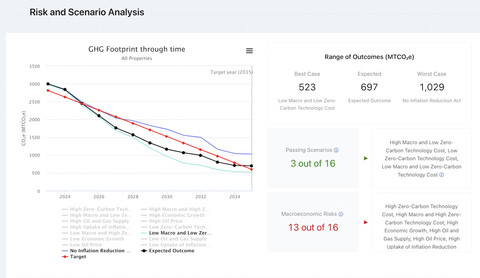News Brief
New Tool Supports Existing Building Decarbonization at Scale
Many building owners are just waking up to the massive carbon footprints of their portfolios. The higher their emissions are, the greater the financial and reputational risks. And owners face increasing pressure to disclose climate-related risks to investors and the public through environmental, social, and governance (ESG) reporting.
Meanwhile, existing building portfolios can be nightmarishly complex, requiring huge investments in bespoke decarbonization plans that can take years to develop—let alone implement. The world doesn’t have that kind of time.
Carbonsight, a new tool from Autocase, is designed to speed up the process through automation, visualization, and a dash of artificial intelligence (AI).
Carbonsight can project whether a building portfolio will meet the owner’s decarbonization targets based on macroeconomic factors alongisde user-entered data.
Instead of manually entering one intervention at a time, users can also choose an energy goal—like a specific lighting power density—and the system will make projections based on that instead.
Decarbonization roadmaps project whether the portfolio, with the chosen interventions applied, will meet the owner’s decarbonization targets. These projections encompass multiple scenarios—like what would happen if the Inflation Reduction Act were repealed or had low uptake, or how rapidly the cost of zero-carbon building technologies is likely to come down.
Financial analysis at the asset and portfolio levels estimates capital costs and the resulting operational savings. The analysis relies on manually submitted budget projections as well as the tool’s built-in modeling of future energy prices.
“You can play around with which strategies give you the biggest bang for the buck over time,” said Simon Fowell, principal economist at Autocase. He added that Carbonsight is “geared toward owners who have set a target but don’t have a plan of action.”
The tool will not be taking jobs away from building consultants, Fowell emphasized. The idea is to make their jobs easier—and decarbonization faster. “The hardest part for the sustainability consultant is probably building a tool to begin with and getting the data,” he said. “We eliminate as much of the headache as possible.”
Carbonsight pulls from a variety of data sources, including Cambium, which projects region-by-region grid decarbonization. It does not currently factor in the cost impacts of building performance standards (state and local laws that will fine owners for poorly performing buildings), according to Fowell.
With science-based targets soon to be in place for the building industry, more owners will likely set ambitious decarbonization goals. Tools like Carbonsight, CARE, and the proprietary GOLD software can help owners achieve those goals faster and more cost effectively.
Carbonsight users buy an annual subscription (which allows an unlimited number of users) for each portfolio they wish to track, Fowell wrote in an email. He added that pricing is based on portfolio size and starts at $5,000 per year.
More on existing building decarbonization
We Must Decarbonize Existing Buildings by 2050—but How?
Investors Will Use EPIC Tool to Decarbonize Existing Assets
Affordable Housing Gets Billions for Resilience Retrofits
High-Efficiency Commercial Window Inserts
For more information:
Autocase
carbonsight.com
Published August 7, 2023 Permalink Citation
Melton, P. (2023, July 26). New Tool Supports Existing Building Decarbonization at Scale. Retrieved from https://www.buildinggreen.com/newsbrief/new-tool-supports-existing-building-decarbonization-scale



Add new comment
To post a comment, you need to register for a BuildingGreen Basic membership (free) or login to your existing profile.